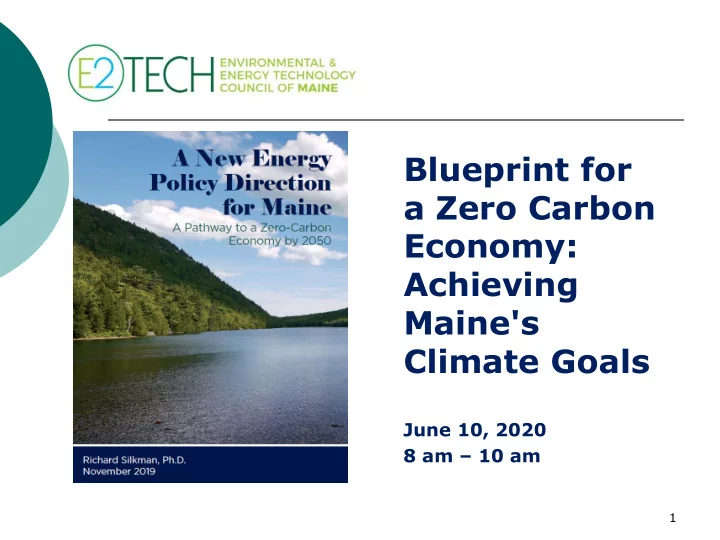

Blueprint for a Zero Carbon Economy: Achieving Maine's Climate Goals June 10, 2020 8 am – 10 am 1
The Zero-Carbon Objective The fundamental policy question of our time – the question that will determine nothing short of the future of the planet – is whether it is possible to transition to a zero- carbon economy by 2050 without jeopardizing the health and vitality of our economy. 2
Zero-Carbon by 2050 I believe that it is. Specifically, in my book I show that it is possible to transition Maine’s economy to zero -carbon by 2050 and in the process spend no more during each of the 30 years of this transition than we are spending on energy today. 3
Zero-Carbon by 2050 To accomplish this objective requires the following: 1. Beneficial Electrification of the Transportation, Heating and Process Sectors of the economy. 2. Decarbonization of Generation through the build-out of renewable generation – solar PV and on-shore and off- shore wind 3. Large-scale Battery Storage systems 4. Commensurate expansion of the transmission and distribution grid – and conversion of that “grid” into a smart, multi-directional electric network 5. The ability to access unprecedented amounts of capital to support the transition 4
Maine’s Energy Use To eliminate CO 2 emissions, Maine needs to convert all energy use to electricity – Beneficial Electrification 5
Beneficial Electrification Converting all end-uses of energy to electricity results in a more than 3-fold increase in total MWhs and an almost 5-fold increase in maximum peak demand. 6
Beneficial Electrification Note the key role played by heating loads. It represents the single most important factor in the ability of northern latitude regions to move to zero-carbon. 7
The 30-year Transition Period Beneficial Electrification – Assumed Conversion Rates Percent Electrical Conversion by End-Use 2020-2050 100.0% 90.0% 80.0% 70.0% Heating 60.0% Residential AC Percent 50.0% Process Passenger EV 40.0% Buses (EV) 30.0% Truck (EV) 20.0% 10.0% 0.0% 2020 2021 2022 2023 2024 2025 2026 2027 2028 2029 2030 2031 2032 2033 2034 2035 2036 2037 2038 2039 2040 2041 2042 2043 2044 2045 2046 2047 2048 2049 2050 8
Decarbonization of Generation Monthly Distribution of Generation Output by Renewable Generation Technology and Total Electric Load 16.0% 16.0% 14.0% 14.0% 12.0% 12.0% 10.0% 10.0% Load Solar 8.0% 8.0% On-Shore Wind Off-Shore Wind 6.0% 6.0% Hydro 4.0% 4.0% 2.0% 2.0% 0.0% 0.0% Jan Feb Mar Apr May Jun Jul Aug Sep Oct Nov Dec 9
Meeting Electric Loads Develop renewable generation capacity so that annual energy generated is equal to total annual electric load, plus reserve margins. Battery Storage is used to match hourly loads and hourly generation. • Hour-by-hour matching • Diurnal cycling • Multiple day weather variability • Seasonal Loads/generation 10
100% Solar PV Generation Up to a limit, overbuilding renewable generation capacity substitutes for long-term storage. 11
The 30-year Transition Period Decarbonization - Build-Out of Renewable Generation 12
Key Cost/Financing Assumptions Installed Capital Cost Fixed O&M 2020 2050 2020 2050 Existing Hydro $0 $0 $20 $20 ($/kW) ($/MWh) Solar PV $1,500 $602 $10 $10 ($/kW) ($/kW/yr) On-Shore Wind $2,000 $2,000 $10 $10 ($/kW) ($/MWh) Off-Shore Wind $4,000 $4,000 $20 $20 ($/kW) ($/MWh) Battery Storage $500 $41 $10 $10 ($/kWh) ($/kW/yr) Battery Storage - Round-Trip Efficiency Losses 12.5% 12.5% Financing Costs Wgtd. Avg. Cost of Capital 3.0% 3.0% Financing Term (years) 30 30 Debt Service Cost per Million $51,019 $51,019 Effective Property Tax Rate $0 $0 (per thousand of valuation) 13
Total Energy Expenditures Average real expenditures across all forms of energy in Maine have averaged roughly $6 billion – about 10% of GSP … 14
The 30-year Transition Period Total Energy Spending each year is close to the average amount spent each year over the period 2000 – 2016 15
The 30-year Transition Period However, the nature of how money is spent on energy changes from fuel costs to capital costs – from variable costs to fixed costs 16
The 30-year Transition Period Annual and Total Capital Requirements are very significant. The process of getting to zero-carbon can be summarized as the substitution of capital for fuel and O&M in the energy sector. $6,000 $60,000 $5,000 $50,000 $4,000 $40,000 Battery Storage Off-Shore Wind Millions Millions $3,000 $30,000 On-Shore Wind Solar Delivery Plant $2,000 $20,000 Cumulative Investment $1,000 $10,000 $0 $0 2020 2021 2022 2023 2024 2025 2026 2027 2028 2029 2030 2031 2032 2033 2034 2035 2036 2037 2038 2039 2040 2041 2042 2043 2044 2045 2046 2047 2048 2049 2050 17
The 30-year Transition Period Path of CO 2 Emissions is determined by the speed of both Beneficial Electrification and Renewable Energy Development. CO 2 Reduction from Base Year 2020 25,000,000 20,000,000 15,000,000 Short Tons 10,000,000 5,000,000 0 2020 2021 2022 2023 2024 2025 2026 2027 2028 2029 2030 2031 2032 2033 2034 2035 2036 2037 2038 2039 2040 2041 2042 2043 2044 2045 2046 2047 2048 2049 2050 18
Thank You For electronic copies of my book – visit https://www.competitive- energy.com/zero-carbon-maine rsilkman@competitive-energy.com
Recommend
More recommend